|
Welcome to the Fall 2016 edition of Living on the Edge, the newsletter of the Coastal Wildlife Conservation Initiative (CWCI)! This is a quarterly newsletter to update Florida Fish and Wildlife Conservation Commission (FWC) staff, partners and members of the public interested in Florida’s coastal issues about current projects and other points of interest. Regular highlights will include featured projects related to coastal wildlife, interviews with our staff or partners, special seasonal considerations, news and events, and current funding opportunities. If you are interested in spreading the word about your project or someone who is doing a fantastic job in coastal conservation, please contact the CWCI Coordinator, Fara Ilami, at fara.ilami@myfwc.com.
The Coastal Wildlife Conservation Initiative is an FWC-led multi-agency strategy to address threats to coastal wildlife and habitats, while considering human interests and uses of Florida’s coastal areas. The goal is a statewide, cooperative process to protect coastal wildlife populations, conserve and manage coastal ecosystems, and achieve balance between conservation and opportunities for recreation, commercial activities and responsible development.
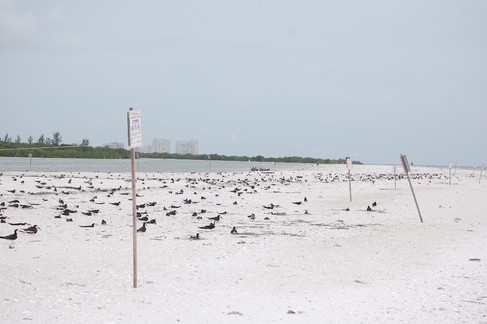
Some of Florida’s most vulnerable wildlife are about to benefit from an unprecedented conservation effort designed to help ensure their survival. At its November meeting, the Florida Fish and Wildlife Conservation
Commission (FWC) approved a proposal to designate 13 new Critical Wildlife Areas
and improve five existing CWAs. Read more...
Back to Top
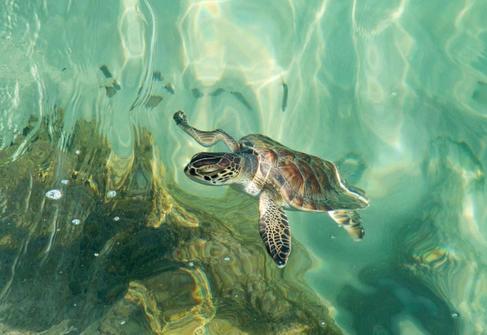
The winner of this summer’s photo contest was Robbyn Spratt
of Brevard County Natural Resources Management Department. She captured a
surreal photo of a juvenile green sea turtle. Congratulations to Robbyn!
Back to Top

Each year the Ocean
Conservancy hosts the International
Coastal Cleanup (ICC) on the third Saturday in September to collect trash
from beaches and associated areas around the world. Although it is global in
scope, each local community organizes its own cleanup event(s). Volunteers help collect data about the different
types of trash that are picked up, and local organizers send these data to the
Ocean Conservancy to compile. In addition, the ICC day marks the beginning of National Estuaries
Week, which celebrates the many ways we benefit from healthy, thriving
coastal ecosystems. All throughout the country, local organizations conduct
events to recognize the special role these places play in our everyday lives. Beach
cleanups, hikes, canoe and kayak trips, workshops and more are led by National Estuarine Research Reserves,
National Estuary Programs and member groups with Restore America’s Estuaries.
This year, the CWCI decided
to partner with several organizations around the state of Florida to include an
educational component to the cleanups and estuary activities. Some of the local
sites had a mini eco-festival associated with their cleanup, where different
organizations such as the CWCI set up booths and tables for people to visit as
they ate lunch. Other sites had no such festival, and the CWCI was the only
outreach setup at the event. Since there was not enough staff to make it to all
the events around the state, materials were sent to the coordinators at many
sites to distribute themselves.
In addition to the important goal of cleaning up trash threatening
marine and coastal wildlife, the CWCI had four main goals for the event: 1)
Make people aware of the benefits of biotic beach wrack
and encourage them to leave the biotic material in place for the benefit of
wildlife, 2) Encourage the reduction of mechanical
beach cleaning (beach raking) to allow native vegetation to stabilize the
beach and provide habitat for wildlife, 3) Alert people to the potential
presence of wildlife on the beaches that they may be cleaning up and best
practices to avoid disturbance of wildlife while they are cleaning, and 4) Make
people aware of the existence of the CWCI and how we may be of service in the
future. To accomplish these goals, materials were distributed such as a Beach Wrack ID
Guide, a brochure and magnet entitled “Grow a Better
Beach,” and other brochures
about preventing wildlife disturbance.
Attendance at the ICC events throughout Florida was strong:
- Lee County had over 2,000 volunteers and
collected over 8,000 pounds of trash.
- A group in Key Largo (Pirates on the Water) had
a smaller number of volunteers but was still able to collect over 700 pounds
of trash.
- Friends of Palm Beach collected 750 pounds of
trash with just 62 volunteers.
- Franklin County volunteers collected 10.93 tons of trash and found
some rather interesting items — a Darth Vader case, Tonka toy truck, skull of a
wild hog, bathroom sink full of oyster shells, fire hydrant, car headlight,
refrigerator, bear trap, nine baseball caps, men’s underwear, and a (half)
bottle of rum.
- Lake Powell Community Alliance had 88 volunteers and hosted an
educational display.
In addition to the ICC, some of the sites have multiple
cleanups throughout the year, such as the Treasure Coast Naturists who clean
every weekend.
The Beach Wrack ID
Guides were very popular with both adults
and children at many of the sites, and some of the coordinators requested
additional copies for other events or for next year’s ICC. The CWCI had
requested that coordinators put out a sign-up sheet for people who were
interested in receiving this quarterly newsletter or otherwise being involved
with the CWCI, and many people at various sites signed up, including high
school students and teachers.
Last year, Florida collected a total of 745,164 pieces of
trash from coastal areas. These included items such as cigarette butts, bottles
and caps, straws, lids, cans, plastic bags, fishing gear, packaging materials,
appliances, balloons, construction materials, and personal hygiene items, among
other things. By far, the most abundant item was cigarette butts (240,225),
accounting for 31.54% of the total amount of trash collected. The second most
abundant was plastic bottle caps (72,119), which made up 9.53% of the total.
The data for this year’s cleanup is not yet available, but once it is compiled,
it may be accessed at the Ocean Conservancy’s Marine Debris
Database.
The organizations that partnered with the CWCI on the 2016
International Coastal Cleanup and/or National Estuaries Week included the
following: Volusia County Environmental Management, Citrus County Department of
Water Resources, Friends of Jupiter Beach, Reef Medics, Friends of Palm Beach, Adventure
Outpost, UF/IFAS Extension, Pensacola State College, Topsail Hill Preserve
State Park, American Tower Corporation, Keep Collier Beautiful, Manatee County
Parks and Natural Resources, Sea Angels, NOVA Southeastern University, City of
Riviera Beach, City of Greenacres, Franklin County, Bald Point State Park, Delray
Beach Parks and Recreation, Keep Lee County Beautiful, U.S. Fish and Wildlife
Service, Lake Powell Community Alliance, Pirates on the Water, Friends of South
Walton Sea Turtles, Treasure Coast Naturists, American Association for Nude
Recreation, Keepers of the Coast, and Guana Tolomato Matanzas National
Estuarine Research Reserve.
Additionally, CWCI staff have been working with other FWC
staff as well as numerous state and local agencies, organizations, and NGOs
throughout the state to draft the first statewide guidance plan to address
marine debris reduction in Florida. Team edits are currently being incorporated
into the draft document, and the Florida Marine Debris Reduction Guidance Plan
will be going out for stakeholder review over the next several months. This is
the first step in collaboratively and comprehensively addressing the issues
surrounding the impacts of marine debris at a statewide scale.
Back to Top
|
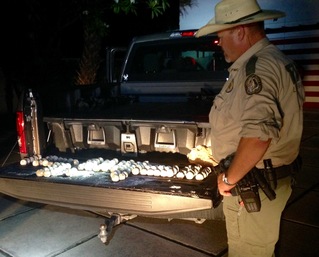
Our second featured project highlights quite a different
aspect of coastal conservation — law enforcement. A sea turtle egg poacher was
caught red-handed and arrested by FWC law enforcement officers in July. Glenn
Robert Shaw was charged with the taking
and possession of 107 loggerhead sea turtle eggs, a third degree felony, punishable by up to 5 years in
prison and a fine up to $5,000. This was the first capture of a sea turtle egg
poacher in Florida in two years. The last poacher arrested, James Odel McGriff,
was caught with 299 eggs in August 2014.
Five days prior to the
arrest of Shaw, FWC Division of Law Enforcement received information from FWC
biologists regarding a possible suspect poaching sea turtle eggs from a beach
behind a residence on Jupiter Island, which had a large number of marked turtle
nests. When FWC Marine Turtle Permit Holders come across nests that have been
tampered with by humans, they contact the FWC Division of Law Enforcement to
investigate further. Their observations on the beach often provide valuable
assistance to catching the poachers.
After receiving the tip, officers increased patrols in the area to
monitor for illegal activity. At approximately 10:30 p.m. on July 1, FWC
officers observed Shaw in the process of taking eggs from a female loggerhead
sea turtle as she was laying them. Shaw was found to be in possession of 107
eggs. He was booked into the Palm Beach County Jail and charged with a third
degree felony for the taking and possession of the threatened loggerhead sea
turtle eggs. The US Fish and Wildlife Service assisted FWC officers in this
arrest. The arrest occurred away from the nest, and the female loggerhead
returned to the water with no unusual behavior observed.
As for the eggs, 15
of them were kept as evidence and for DNA testing. FWC has a
wildlife forensic lab at the West Palm Beach regional office. FWC biologist,
Hector Cruz-Lopez, runs the lab and coordinates the testing. Some testing is
done in-house and some is done in other labs throughout the US. The remaining 92 eggs were re-buried by FWC
biologists so that they may hatch later this year. They were
re-buried in the original nest cavity within 4 hours of deposition and in
accordance with relocation protocols included in the FWC Marine
Turtle Conservation Guidelines. The protocol requires that eggs be
moved no later than 12 hours following deposition, because after this time the
potential for movement-induced mortality in sea turtle eggs increases rapidly. The
hatching status of the eggs will be announced after the case is over.
The poacher’s motive
is still being determined at this time, and the investigation into this case is
still ongoing. However, it is known that the black market for marine turtle eggs
still exists, and one of the prime locations for the U.S. market is in Riviera
Beach, which is near Jupiter Island where the poacher was caught. Thanks to
diligent efforts by FWC law enforcement, poachers are at greater risk and have
been less successful in obtaining eggs in recent years.
Florida outlawed the poaching of sea turtle eggs in 1953,
but poaching arrests didn't become common until the 1980s. Even though
enforcement has increased over the years, conviction is rare. Many poachers are
actually repeat offenders. Although state law allows judges to send poachers to
jail for a year if caught molesting a nest, it's rare for officers to actually
catch them with their hands in the sand. There are several challenges to
reducing sea turtle egg poaching: lack of enough state and federal wildlife agents
to patrol the beaches effectively; lack of enough minority officers to be able
to infiltrate the predominantly minority markets for undercover operations; the
current law which typically allows for only short sentences even for repeat
offenders; and lack of an organized effort to track poaching. Poachers have
told police they intend to keep working despite the possibility of tougher
penalties. They know their profits will increase if the eggs become harder to
obtain. And they know conservation efforts, which have increased the number of
turtle nests in Florida will, ironically, add to their supply.
Back to Top
|
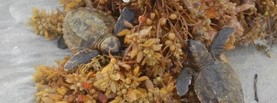
Washbacks are defined as post-hatchling sea turtles, with
a carapace length between 5cm-10cm, which have washed back to shore. They are
generally a few weeks old. Typically found July 1st through November
30th, these washbacks are generally the product of large storm
events or high onshore winds. Large amounts of wrack are also washed back
onshore during such events, and washbacks are often found mixed in with the
marine plant detritus. Due to the risk to these small protected animals, FWC
biologists recommend that beachfront communities use manual cleaning methods to
pick up manmade beach debris rather than large beach cleaning machines.
Operators of beach cleaning equipment are unlikely to detect the washbacks that
are uniquely adapted to blend in with the seaweed and algae to avoid
depredation in the open ocean. Washbacks are most often post-hatchling sea
turtles that were too weak or otherwise debilitated to fight the strong
currents. Washbacks typically only need a little rest, nutrition and
rehydration before they can be released to continue on their journey. Only FWC
staff and Marine Turtle Permit Holders or their authorized personnel are
allowed to handle sea turtles, including washbacks. If you come across
washback sea turtles or any other sea turtle hatchlings, report it to the FWC’s
Wildlife Alert Hotline: 888-404-FWCC (3922), #FWC or *FWC on a cell phone, or
by texting Tip@MyFWC.com.
If you are in the Brevard,
Volusia or St. Johns County area and are an avid beach walker, you may want to
consider volunteering with Sea
Turtle Preservation Society’s Sea Turtle ER Program (in Brevard County), Volusia County’s Washback Watcher program or St. Johns County Beach Steward program. Volunteers must undergo training to find and rescue these
post-hatchling sea turtles, and are specifically authorized by FWC to conduct
this important work.
Fall Beach
Tips:
- Use of mechanical
beach cleaning equipment is discouraged on beaches with imperiled species and
should be limited or eliminated whenever possible.
- When possible, conduct mechanical
cleaning only during times when nesting and hatching are not occurring.
- Leave as much fresh wrack as possible
in place — at least one-third — to provide foraging habitat and cover for
coastal species. Beach wrack is not
“dirty”. It is part of a natural healthy
beach and dune system and is integral in promoting natural shorelines that are
essential for effective shoreline stabilization and storm protection.
-
Remove human-generated debris
(plastics, balloons, monofilament line) in or near the wrack line by hand.
- Promote “pack-in/pack-out” practices for garbage and the ecological
value of leaving the beach wrack intact.
- If mechanical cleaning must occur
during the sea turtle nesting season, special precautions should be taken.
- Sea
turtle nesting surveys and associated conservation measures shall be
completed after sunrise and prior to the commencement of any mechanical
beach cleaning each day beach cleaning takes place. No beach
cleaning or other permitted activity can
occur on the beach until the daily morning nesting surveys have
been completed. If hatchlings are
found on the beach, contact the FWC-authorized Marine Turtle Permit Holder
(MTPH). Do not resume beach cleaning activities until the MTPH gives the
all clear.
Back to Top
|

1. What is your title? Florida Beaches Habitat Conservation Plan (FBHCP) Statewide
Coordinator
2. What organization do you work for? Florida Fish and Wildlife Conservation Commission, Division of
Habitat and Species Conservation
3. What type of work do you do? I currently oversee the development of the
nation's first statewide beaches habitat conservation plan which covers ~825
miles of sandy beaches in Florida. The FBHCP integrates coastal development and
land use activities with conservation by providing a framework for the
preservation and management of threatened and endangered species of plants and
animals including sea turtles, shorebirds and beach mice. I provide subject
matter expertise on conservation issues both regionally and statewide as well
as act as a liaison between FWC and its partners including federal, state and
local government agencies and organizations, as well as a wide variety of
stakeholders. My job involves a lot of travel and meetings as well as some
field work, all focused around the beaches of Florida. In addition to this
position, I am also part of the Coastal Wildlife Conservation Initiative (CWCI)
team, hold the position of Courtesy Faculty at the University of Florida’s
College of Veterinary Medicine (aquatic animal health research), serve as a
Steering Committee Member on the Gulf of Mexico Alliance’s Marine Debris Cross
Team Initiative (GOMA-Marine Debris CTI), and Co-Lead the Wildlife and Habitat
Impacts Group (WHIG) as part of the Florida Marine Debris Reduction Guidance
Plan development team.
4. What project(s) have you recently been working on? The
FBHCP is currently in its ninth year of development and we are rapidly
approaching finalization of the draft Plan and submission to the US Fish and
Wildlife Service (to be completed spring 2018). We are heavily focused on
completing the draft chapters on minimization and mitigation measures. The
measures outlined provide the framework for avoiding, minimizing and mitigating
any potential impacts or threats to the listed species on Florida’s sandy
beaches as a result of permitted coastal activities, events, and/or
development. I have also been spending considerable time working with our
legislative staff and agency partners as we work towards finalizing the Plan’s
implementation strategy. As we finalize the remaining draft chapters of the
FBHCP, and given that this is a statewide Plan that impacts a significant
portion of the coastal activities occurring in the state, much of my time in
2017 will be focused on outreach with stakeholders throughout Florida.
Recently, in a collaboration among FWC, FDEP, NOAA, and
numerous agencies and organizations from around the state, I have also been
assisting in the development and agency review of the state’s first Plan to
address marine debris in Florida. The Florida Marine Debris Reduction Guidance
Plan (FMDRGP) will be going out for stakeholder review in fall 2016. Both the
FBHCP and the CWCI address marine debris issues in Florida at various levels,
with the underlying goal of restoring and/or preserving quality sea turtle and
shorebird nesting habitat.
5. How does your work relate to the CWCI? Since my work covers all
sandy beaches in Florida, there is a high degree of overlap with the work of
the CWCI. Much of my work with the CWCI has focused on addressing the impacts
of mechanical beach cleaning and marine debris on coastal species and
habitats. Most recently, we have also
been working on several projects related to promoting the importance and
increased use of living shorelines as a means of natural and effective
shoreline stabilization vs. coastal hardening which can have negative impacts
on both coastal wildlife as well as the integrity of the beach itself.
6. How long have you been working in the coastal
environment, and what are some lessons you have learned? I have been working in
the environmental field for a little over 17 years, 15 years of which has been
largely coastal, marine, and/or riverine focused. I grew up in NY, but was a
frequent annual visitor of Florida. I have been fortunate to work, study and
live in some of the most beautiful places including Brazil (Amazon), the UK,
Australia, Belize, Cuba, New York, Texas (coastal), and now Florida. I moved to
Florida in 2006, having just returned from Australia where I was conducting
humpback whale research and living on a 13 meter catamaran. My Florida career
began working for Volusia County, after which I moved a bit more inland and
north to Gainesville for graduate school. After finishing my Ph.D. and staying
on with the University of Florida for a year teaching and conducting research,
I headed a bit more north again, this time to Tallahassee, where I have been
based since 2013.
I have learned so many lessons along the way, but here are
a few that stuck with me the most: 1) If you don’t ask or don’t take a chance,
the answer will always be ‘no’, 2) Try new things and embrace the unexpected,
3) Aim Big, 4) Collaborations are essential, 5) It all comes down to passion
and perseverance, and 6) If you’ve got mud on your feet, salt in your hair, or
sand in places you didn’t think it could go … chances are, it’s been a pretty
awesome day.
7. What do you think is the greatest threat to coastal
ecosystems, and what action(s) should be undertaken to address it? There are many threats to our coastal
ecosystems, but I think one of the biggest threats is the viewing of our
coastal systems as a resource for us to use rather than an integral part of a
healthy, thriving, natural environment in Florida. Finding the balance between
human activities along the coast while preserving the biological needs of the
coastal systems by not only maintaining and/or increasing the quantity of
habitat but also maintaining and/or improving habitat quality, is an ever
increasing challenge. The FBHCP addresses such challenges by integrating
coastal development and land use activities with conservation, thus providing a
framework for the preservation and management of threatened and endangered
species on Florida’s beaches.
8. What is your favorite coastal animal, and why? It’s impossible for me to pick just one … but I think my
top 5 would be 1) sea turtles — Kemp’s ridley and green, both of which nest on
Florida beaches, 2) cownose stingrays (always loved them, more pelagic but also
found in inshore waters), 3) manatees (yes they do travel along the coast,
mainly in the warmer months), 4) humpback whales, which migrate, sometimes
quite close to shore, along Florida’s east coast in the winter months, and 5)
the blue sea slug, also known as the ‘blue dragon,’ ‘sea swallow’ or ‘blue
angel,’ a mostly pelagic species that is sometimes brought close to or onshore
by winds and ocean currents. This oceanic nudibranch floats upside down in the
water, feeds on the Portuguese man o’ war and blue buttons — sequestering the
most venomous nematocysts from its prey for its own use, and is just one of the
most unique and beautiful animals I’ve ever seen!
9. Do you have a message you would like to share with
readers of this newsletter?
We must lessen our footprint in nature.
Take Action! Those little steps, little actions … they add
up to make a BIG difference. “The greatest threat to our planet is the belief
that someone else will save it.” ~ Robert Swan
Find what you’re passionate about, and go for it.
Get Outside and Play!! It’s a beautiful world!
Back to Top
|
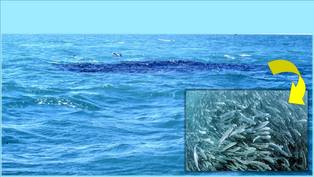
This fall’s Critter of the Quarter is the striped
mullet (Mugil cephalus),
which is most notable during the early fall when it forms into large schools
and migrates offshore to spawn. This behavior is commonly called the “mullet
run.” The striped mullet ranges in color from a grayish to olive-brown, and
gets its name from the spots found on each scale that resemble stripes when
viewed at a distance. They can reach sizes up to 120 cm and weights of over 6.8
kg. This species occurs worldwide in warm temperate to sub-tropical waters. In
Florida, this fish can be found in all coastal waters and can tolerate a wide
range of salinities (0 – 77 parts per thousand). This allows it to occur inland
in freshwater rivers, to hyper saline lagoons and offshore, where this
catadromous species spawns. Catadromy refers to the fact that even though this
fish is primarily found in freshwater and estuarine regions, it migrates
offshore in saltwater to spawn.
Mullet are an essential link in the energy flow within
estuarine systems. As schooling fish, large groups of juveniles are common in
very shallow water, feeding on zooplankton. Adults also form large schools,
commonly feeding on detritus found on the surface of sediments over mud or sand
flats. In areas with large amounts of seagrass, they eat the epiphytes
(non-parasitic plants that grow on the seagrass) or epifauna (animals that live
on seagrass). Striped mullet are a food source for many popular sport fish,
such as speckled trout, redfish, snook, tarpon, billfish and sharks, to name a
few.
Since they are a preferred prey item for so many
recreationally important species, the mullet run, or spawning migration, is
eagerly anticipated by fishermen. During this time, it is easy to catch both
mullet and predatory sport fish in large numbers. As temperatures drop in the
fall, schools of adult mullet begin to exit freshwater and brackish
environments and move along the coast, joining up with other schools to form
huge masses of thousands of fish, and migrate along the coastline before
eventually moving offshore. Anglers and predators alike gather to intercept the
schools and take advantage of the favorable fishing opportunity presented by
having so many fish concentrated in such a tight group. With the increase in
the use of drones, there is some truly spectacular footage of the mullet run now available to give a bird’s eye view of
the many dynamics of the mullet run.
Striped mullet are harvested both commercially and
recreationally for human consumption and bait, often with baitfish selling at
higher prices. The roe, or eggs, are also considered a delicacy in many
cultures. During the 1980s and early 1990s, striped mullet were rapidly
declining due to overfishing by commercial fishermen, who were able exploit the
schooling nature and annual migration to an extreme extent. Since Florida
enacted the net ban in 1995, which prohibits use of any entanglement net
designed to ensnare an animal in the meshes, this species has rapidly recovered
while still remaining available for harvest by other means. This had the added
benefit of protecting many non-targeted species (sea birds, marine mammals, sea
turtles, non-target fish), known as by-catch, which were often inadvertently
captured in entanglement nets and often died as a result of prolonged
entanglement.
Back to Top
|
Center for Dark
Energy Biosphere Investigations Education Small Grants Program —
C-DEBI Education & Outreach Grants Program will fund the development of
educational opportunities and materials that are pertinent to deep biosphere
research in the subseafloor environment. The deadline is December 1, 2016.
NRDA Florida Trustee
Implementation Group (TIG) Project ideas Requested for Restoration in
Florida — New project ideas
or revisions of previously submitted projects are being accepted. The deadline
is December 5, 2016.
Gulf of Mexico
Alliance Coastal Community Small Grants — Proposals are now being accepted
from coastal communities who wish to proactively address their vulnerabilities
to coastal hazards identified during a community self-assessment. The deadline
is December 9, 2016.
Temper of the Times Foundation
— Provides funds to nonprofit organizations for environmental advertising projects
that will lead to measurable outcomes for wildland ecosystem conservation and
restoration. The deadline is December
15, 2015.
NOAA Marine Debris
Program Marine
Debris Research FFO — This
opportunity provides funding for original, hypothesis-driven research projects
focused on the persistence and chemical impacts of marine debris. The deadline
is December 19, 2016.
NOAA FY17 Coral Reef
Conservation Program Domestic
Coral Reef Conservation Grants — Applications accepted for projects
will fall within at least one of the following four categories: (a) Fishing
Impacts; (b) Land-Based Sources of Pollution; (c) Climate Change; and (d) Local
and Emerging Management Needs. The deadline is January 11, 2017.
EPA
Environmental Justice Small Grants Program –Applications should reflect
activities that empower and educate affected communities to understand
environmental and public health issues and to identify ways to address these
issues at the local level. The deadline is January
31, 2017.
Back to Top
|